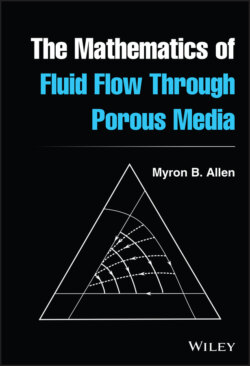Читать книгу The Mathematics of Fluid Flow Through Porous Media - Myron B. Allen III - Страница 20
2.2.1 Mass Balance
ОглавлениеConsider first the mass balance. We associate with each body a nonnegative, integrable function , called the mass density. This function gives the mass contained in any region of three‐dimensional Euclidean space as the volume integral
having physical dimension . Here, denotes the element of volume integration. Since is nonnegative, so is the mass. The expression (2.2) requires that .
The mass balance arises from a simple observation: The rate of change in the mass inside any region of three‐dimensional space exactly balances the rate of movement of mass across the region's boundary. In symbols,
This equation is the integral mass balance. Here, denotes the boundary of ; denotes the unit‐length vector field orthogonal to and pointing outward, as Figure 2.5 depicts; and denotes the element of surface integration. We call the function in the integral on the right side of Eq. (2.3) the mass flux per unit area; the integrand is the component of mass flux per unit area in the direction of the unit vector , that is, outward from . The surface integral itself, together with the negative sign, is the net flux of mass inward across .
Often of greater utility than the integral equation (2.3) is a pointwise form of the mass balance, valid when the density and velocity are sufficiently smooth. To derive this form, consider a region that does not change in time. In this case,
Also, by the divergence theorem,
where denotes the divergence operator. With respect to an orthonormal basis ,
Applying the identities (2.4) and (2.5) to the integral mass balance (2.3) yields the equivalent equation
valid for any time‐independent region .
If the integrand in Eq. (2.6) is continuous, then the integrand must vanish:
Equation (2.7) is the differential mass balance.
Exercise 2.2 Verify the principle used to derive Eq. (2.7) from the integral equation (2.6). An argument by contradiction may be the easiest approach: Assume that the integrand on the left side of Eq. (2.6) is positive at some point at some time . Since this function is continuous, it must be positive in a neighborhood of at time . Consider a fixed region contained in this neighborhood. A similar argument dispatches the possibility that the integrand is negative at some point.
Exercise 2.3 Justify the following equivalent of the mass balance (2.7):
The differential mass balance in the form (2.8) facilitates another observation. In certain motions, the density following any particle is constant. In this case, , so the mass balance implies that
In this case, we say that the motion is incompressible. This concept does not imply anything about the material being modeled; it merely describes the motion based on properties of the velocity field. A compressible material can undergo incompressible motion.
The mass balance is the simplest of the balance laws of continuum mechanics. Other balance laws include the momentum balance, the angular momentum balance, and the energy balance. A related thermodynamic law known, as the entropy inequality, also plays an important role in many settings. In each of these laws, an integral version is fundamental, and it is possible to derive differential versions under certain continuity conditions. For a detailed review of the integral balance laws and the derivation of their differential versions, see [4]. With the exception of several applications of the mass balance discussed in Chapters 5 and 6, the remainder of this book focuses on differential balance laws.
